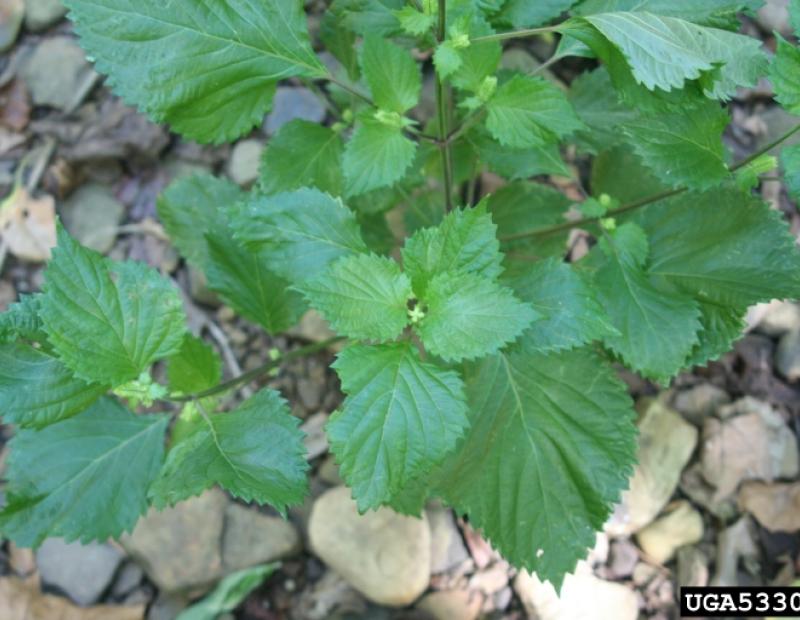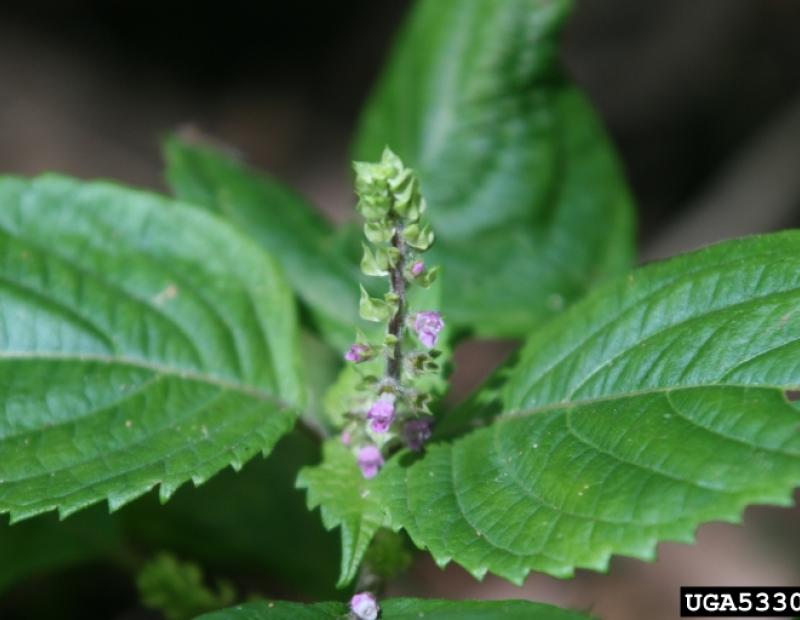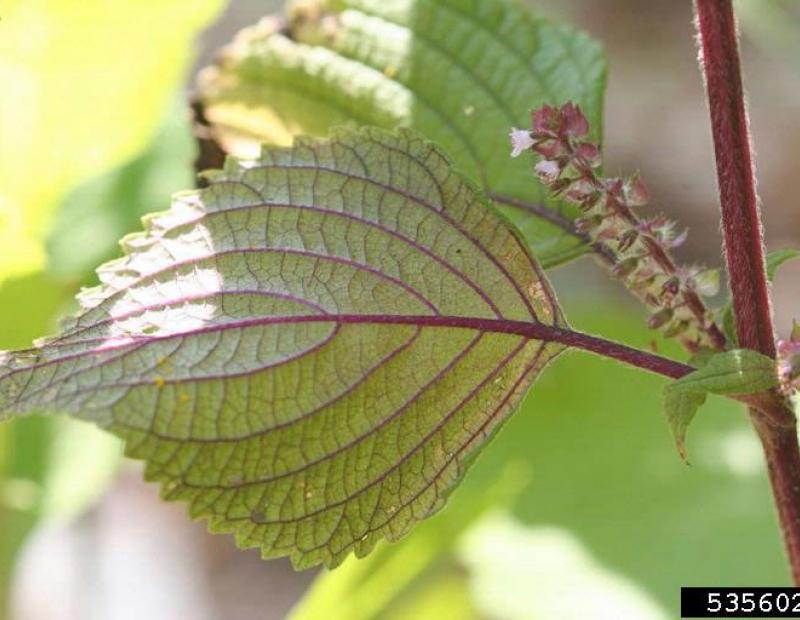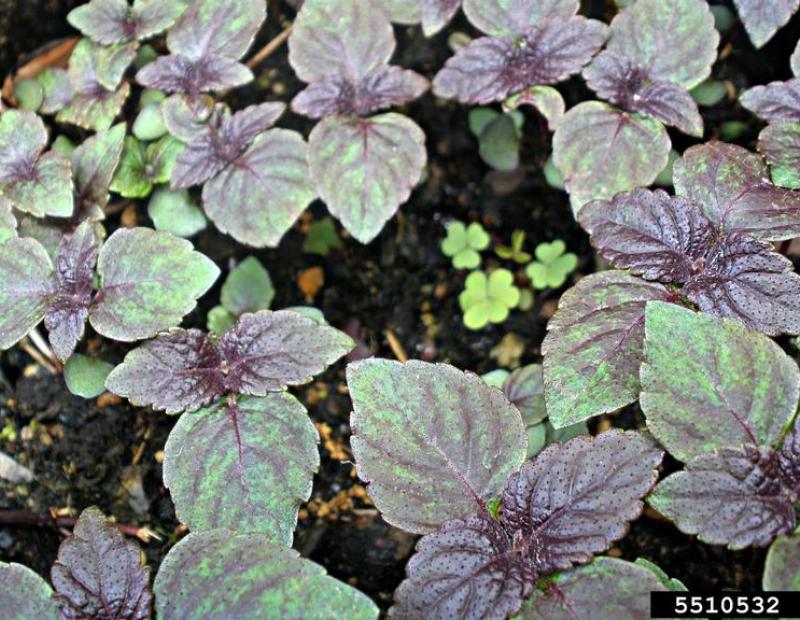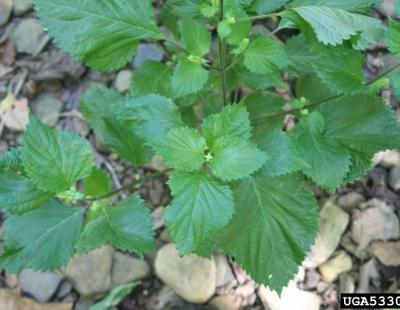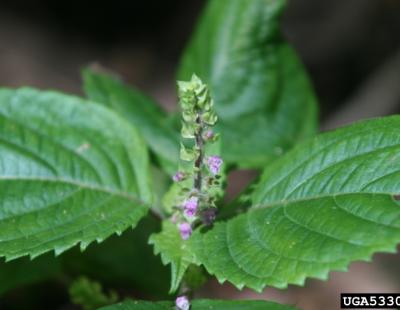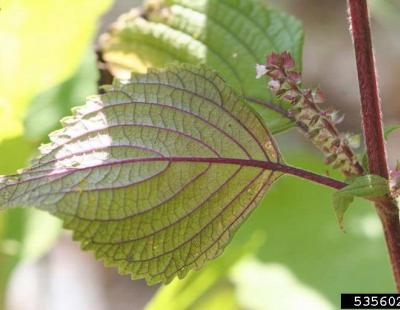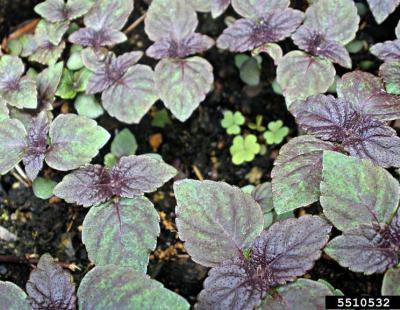Vertical Tabs
- Beefsteak plant is a member of the Mint family (Lamiaceae).
- A popular foliage annual, Beefsteak plant is native to the Himalayas to southeast Asia. Growing three to four feet tall, this species has conspicuous green and purple tinged leaves. As a member of the mint family, all parts of this plant are aromatic.
Leaves
Leaves are wrinkled, up to four inches long, with serrate margins and are often purple-tinged. The most common horticultural variety is a striking dark purple. Leaves are fragrant when crushed. (2)
Flowers
Flowers are classic mint-family flowers, with zygomorphic symmetry (flower parts unequal in size with symmetrical halves only in one plane) and two ‘lips’. The species small, white blossoms appear in late summer to fall and are arranged in tall spikes up to four inches high. (2)
Fruit/Seed
The seeds are a dry, rounded nutlet that are grayish-brown in color and ripen in late summer.(1,6)
As a relatively new invader in the Northeast, little is known about the ecological impacts of Beefsteak plant in this region. An annual capable of producing copious amounts of seed, this invasive readily spreads into natural areas, causing alterations in the diversity and heterogeneity of the communities it invades. Additionally, Beefsteak plant is toxic to cattle and is problematic in agricultural areas where hay is an important crop. (1)
Biological Control
There is no biological control agent available at this time.
Manual or Mechanical Control
Pulling / Digging Up: As an annual, seedlings and young plants can be managed quickly and effectively by pulling.
Mowing: Cutting flower heads will limit the species’ seed production, however, pulling these weak-rooted annuals is a much more effective strategy. (7)
Girdling: Not applicable
Prescribed Fire: No information available. Dried, dead stems of beefsteak plant are highly flammable. (7)
Prescribed Grazing: Not advisable. Beefsteak plant is toxic to most grazers.
Soil Tilling: Not advisable. Tilling can encourage germination. Beefsteak plant will sprout from root fragments. (7)
Mulching: Mulching may inhibit the germination of seedlings.
Solarization: No information available
Hot Foam Spray: No information available
Chemical Control
Foliar Spray: A 1-2% foliar spray of glyphosate during the growing season is effective. Check and re-treat later in the same season to catch late emergent individuals prior to seed production. (9) Always read and follow all directions on the herbicide label and take care when applying in wet areas.
Cut Stump: Not applicable
Basal Bark: Not applicable
Stem Injection: Not applicable
Pre-Emergent Spray: Picloram and dicamba sprays can be applied to the soil preemergence, before rain, to inhibit seedling germination. (5)
The pesticide application rates and usage herein are recommendations based on research and interviews with land managers. When considering the use of pesticides, it is your responsibility to fully understand the laws, regulations and best practices required to apply pesticides in a responsible manner. At times, the pest you seek to treat may not be listed on a pesticide label, requiring a 2(ee) exemption from NYSDEC. Always thoroughly read the label of any pesticide and consult the NYSDEC or a licensed pesticide applicator with questions.
As with any other invasive infestation complex, Beefsteak plant is best managed via a combination of mechanical and chemical means. Small populations may be effectively controlled by hand pulling. Larger populations may warrant a foliar spray application. All managed infestations should be monitored for at least three years to manage any germination of new seedlings that occurs. New seedlings can be hand pulled or sprayed.
Post treatment monitoring
Controlled populations should be revisited once later in the same season of treatment and for at least three years to ensure no germination of new seedlings has occurred.
Disposal Methods
Mowed, cut, or pulled Beefsteak plant can be composted so long as management occurred prior to seed production. Any root material must be thoroughly dried before composting. (7)
REFERENCES
- https://www.invasiveplantatlas.org/subject.html?sub=3413
- http://www.missouribotanicalgarden.org/PlantFinder/PlantFinderDetails.as...
- https://gobotany.newenglandwild.org/species/perilla/frutescens/
- https://hort.purdue.edu/newcrop/CropFactSheets/perilla.pdf
- https://extension.msstate.edu/sites/default/files/publications/informati...
- https://www.invasive.org/alien/pubs/midatlantic/pefr.htm
- https://www.fs.usda.gov/Internet/FSE_DOCUMENTS/fsbdev3_000149.pdf
- https://www.invasive.org/alien/pubs/midatlantic/pefr.htm
- http://mdinvasives.org/iotm/june-2011/

